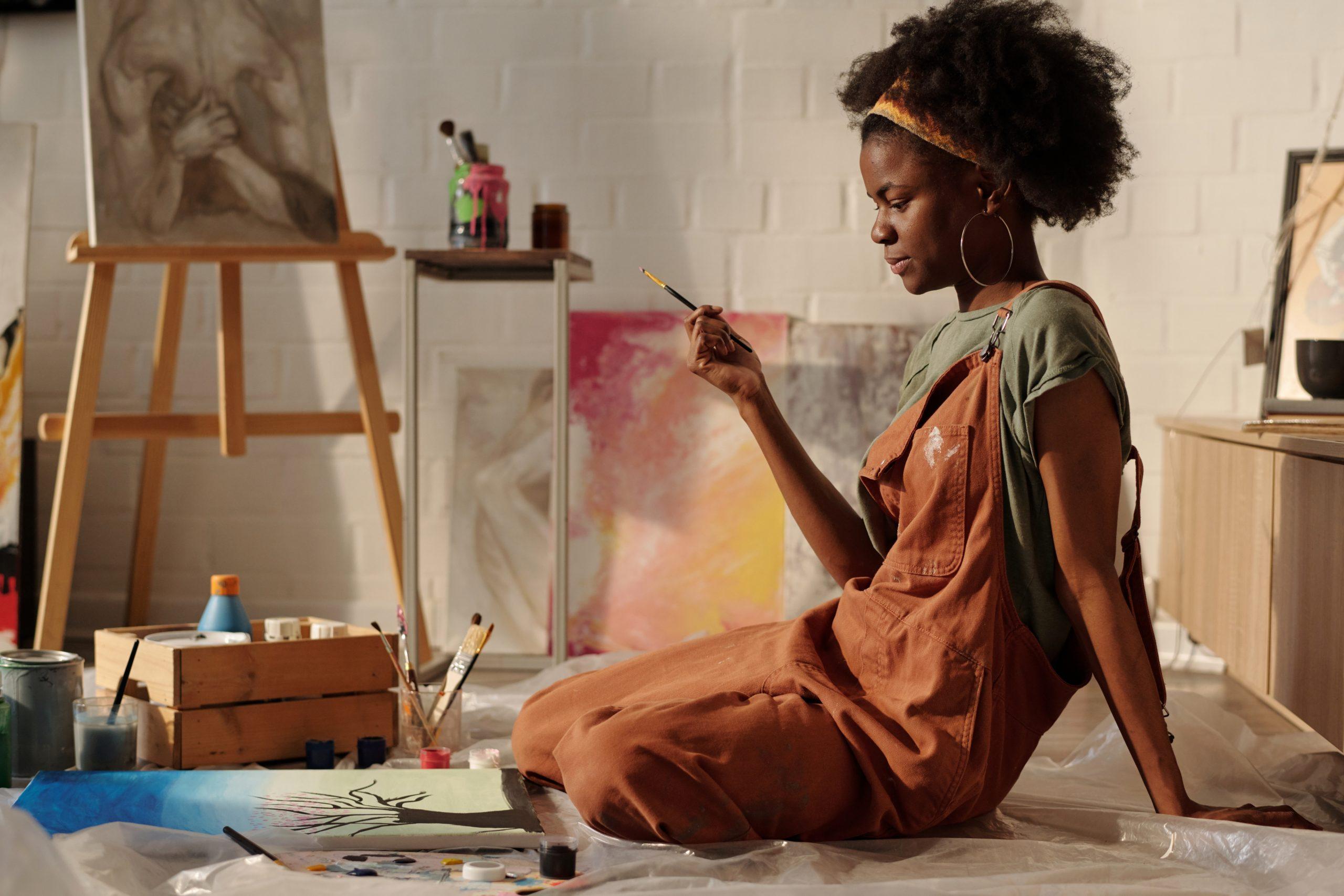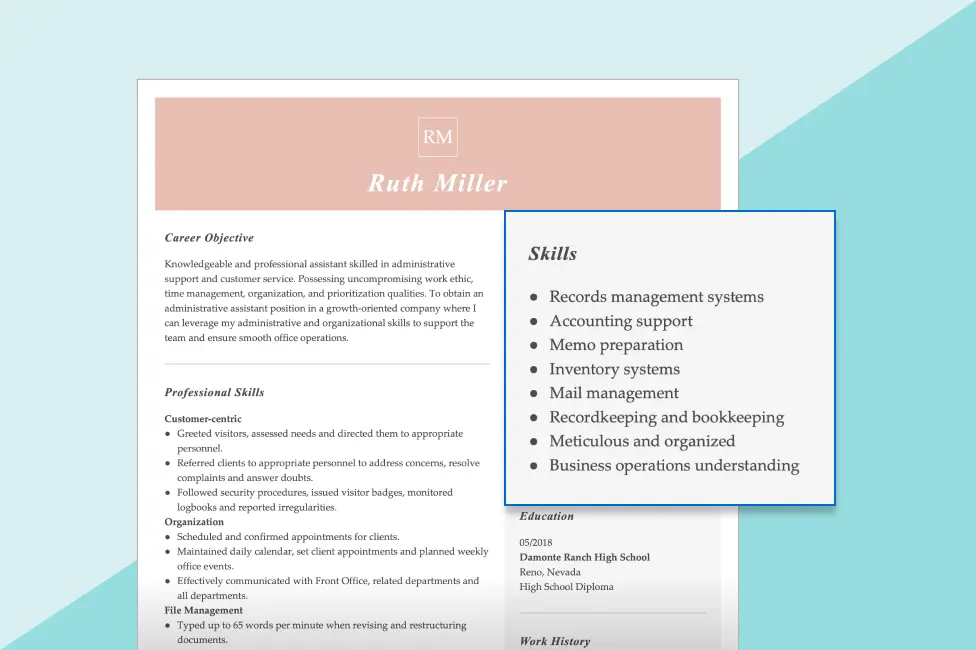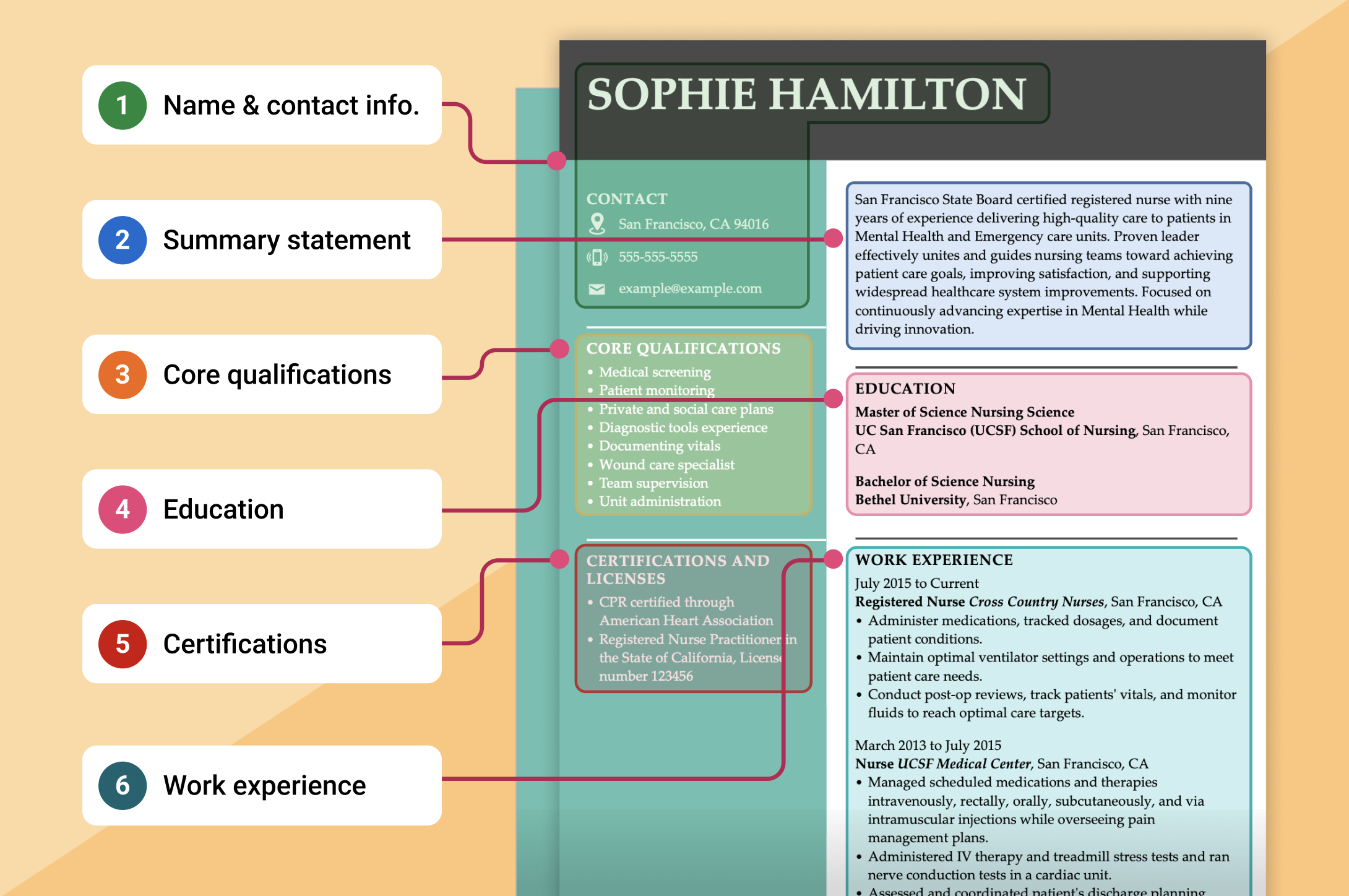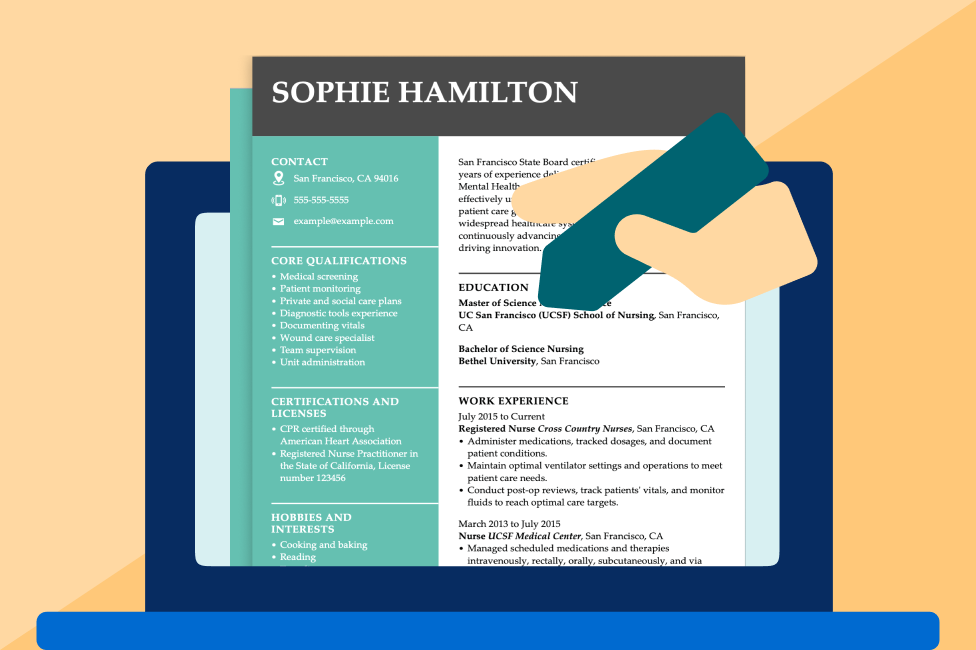Artist CV Example: Writing Guide & Examples
A curriculum vitae is an indispensable document for any working artist. Keep reading to learn the rules for creating an artist CV and examples for various jobs.
Artist CV Example
Every working artist needs a well-written CV to apply for jobs, artist residencies, gallery exhibitions, academic positions or other work opportunities. Creating an artist CV requires you to follow a unique set of formatting rules and include specific sections, as seen in this creative artist CV example below.
How to Write an Artist CV
An artist CV or curriculum vitae is a document that should highlight your exhibitions, residencies, publications and any other relevant achievement in your art career. Not all artist CVs look the same. There are as many ways to customize an artist’s CV as there are artists, but to guide you through the process of writing a CV seamlessly, we’ve created this guide with typical artist CV sections.
Academic CV sections:
- Contact information
- Artist statement or profile
- Education
- Exhibitions
- Residencies
- Grants and awards
- Publications
- Press and media
- Collections
- Teaching experience
- Work experience
- Commissions and projects
- Skills
You don’t have to include every one of these sections on your artist CV; only include the ones that fit your qualifications. You can let our CV Maker do the job for you by simply typing your desired job title and years of experience — our Builder will choose an appropriate artist CV template and suggest expert-written content for all your sections.
Now, let’s begin with our artist CV example writing guide!
1. Contact information
Start your artist CV with a contact information section that lists your name, phone number, email address and a link to your online portfolio or website. If you’re active on social media platforms, link to those social accounts where you share your work.
It’s also customary for artists represented by a gallery to include the gallery’s information so potential clients know who to contact to procure your work.
Example:
Marisa Gómez
Visual Artist | marisagomez@example.com
Durant Leclerc Gallery
Atlanta, GA
www.durantleclerc.com
info@durantleclerc.com
555-555-5555
2. Artist statement or profile
Include a brief artist objective statement or profile consisting of two or three sentences at the top of your CV. This section should convey the essence of your artistic practice, your creative philosophy and the mediums you work in.
Tailor your artist statement to the opportunities you seek, whether exhibitions, grants, residencies or academic and research positions.
It’s common for an artist to include the city and country they were born in since most exhibition labels include that information.
Here’s an example of an art CV profile:
3. Education
List your formal art education, such as degrees, certifications, workshops or master classes. If you’re a self-taught artist, you may include significant art-related training or mentorship experiences that showcase your learning progress.
If you’re a performance artist, include any specialized training programs, residencies or artist retreats that contribute to your skill set, even if they are not academic.
Here’s an example of an artist CV education section:
Master of Fine Arts (MFA) in Painting and Sculpture
School of the Art Institute of Chicago, Chicago, IL
2019 – 2021
Bachelor of Fine Arts (BFA) in Visual Arts
California Institute of the Arts, Valencia, CA
2014 – 2018
Workshops and Certifications:
- Advanced Printmaking Workshop
International Center of Printmaking, New York, NY, 2022 - Art Residency Program
Banff Centre for Arts and Creativity, Banff, Canada, 2020
4. Exhibitions
If you’re a visual artist, the exhibitions section will be the most critical and extensive in your CV. You should list every instance where you exhibited your work, but if the list is long and varied, you should divide it between solo, group and juried categories. For every exhibition you list in your art CV, you should include the exhibition name, gallery or venue, location and date. The best way to organize multiple exhibition entries in your CV is by listing them by year.
Here’s an example of an exhibitions CV section so you can follow the proper order and formatting:
Solo Exhibitions
2024
“Urban Echoes” – Greenfield Gallery, Chicago, IL
2023
“Organic Boundaries” – Riverside Contemporary Art Space, New York, NY
Group Exhibitions
2024
“New Horizons: Art in Transition” – Blue Moon Art Collective, Los Angeles, CA
“Resonance and Response” – The Loft Gallery, Seattle, WA
2022
“Shifting Landscapes” – Aperture Art Space, Austin, TX
“Echoes of the Earth” – EcoArt Gallery, Denver, CO
Juried Exhibitions
2022
“Emerging Voices” – Juried by Sarah Thompson, Modern Art Museum, Houston, TX
2023
“Art Now: A Global Perspective” – Juried by Marcus Lee, International Arts Festival, London, UK
5. Residencies
The Residencies section of your artist CV should highlight those experiences where an organization granted you the opportunity to dedicate yourself to your art for a long time.
Art residencies are important to an artist’s professional life because they demonstrate their commitment to growth, networking and artistic exploration.
When listing your residencies, include the name of the residency program, location and the year(s) of participation. It also helps to share any relevant outcomes or projects you completed, but this is optional.
Check out this example of a residencies CV section:
2020 Artist-in-residence – Banff Centre for Arts and Creativity, Banff, Canada
Focused on site-specific installations exploring the intersection of natural and urban landscapes.
2019 Residency program – The Arctic Circle Residency, International (Svalbard, Norway)
Participated in a collaborative expedition focused on environmental art and climate change awareness.
2018 Artist residency – Anderson Ranch Arts Center, Snowmass Village, CO
Developed a new body of work integrating mixed media and environmental materials, resulting in a solo exhibition.
6. Grants and awards
A grants and awards section will help you demonstrate that peers, institutions and funding bodies have acknowledged and rewarded your work. When listing grants or awards, include vital details such as the name of the grant or award, the awarding organization, and the year you received it.
Here’s how to format a grants and awards section in an artist CV:
Creative arts grant – National Endowment for the Arts, 2022
Awarded for developing a multimedia installation exploring climate change.
7. Publications
A publications CV section will be especially relevant to artists seeking a teaching position in academic environments. In this section, you can include papers, reviews, articles and any academic text you’ve published.
Example:
“Exploring the Urban Landscape: Art and Environment in the 21st Century”
Art Journal, Vol. 68, Issue 3, 2023
A peer-reviewed article discusses integrating environmental themes into contemporary urban art practices.
“Material and Form: Innovations in Mixed Media Sculpture”
Contemporary Art Review, 2022
A critical essay analyzing the evolving use of materials in modern sculpture and their cultural significance.
8. Press and media
A separate section for press and media is standard in many artists’ CVs since it shows that their artwork has received press coverage, visibility, and recognition, which adds to their demand as artists.
Use this example as a reference when writing your artist CV’s Press and Media section:
“The Art of Urban Decay: An Interview with Kate Lanthimos”
Artforum, June 2023
A feature interview discussing the inspiration behind recent exhibitions and the evolving role of industrial materials in contemporary art.
“New Faces in Contemporary Art: Spotlight on Emerging Talent”
The New York Times, April 2022
Included in a feature article highlighting emerging artists with a focus on innovative approaches to mixed media.
9. Collections
If your work is part of any public or private collection, that shows there’s demand for your pieces! Note the collections featuring your work in a separate CV section. Make sure you list them alphabetically. For example:
- Hammer Museum – Los Angeles, CA
- Minneapolis Institute of Art – Minneapolis, MN
- MOCA (Museum of Contemporary Art) – Los Angeles, CA
- Museum of Modern Art – New York, NY
- The Art Institute of Chicago – Chicago, IL
- Walker Art Center – Minneapolis, MN
- Whitney Museum of American Art – New York, NY
10. Teaching experience
If you’re an artist applying to a role in academia, you should include a section listing previous teaching experience, if you have it. A section for teaching experience proves to hiring committees that you’ve developed the skills to teach your discipline.
Here’s an example of how to list teaching experience on an artist CV:
Adjunct Professor of Fine Arts
School of Visual Arts, New York, NY
2019 – Present
- Designed and launched an interdisciplinary course on Sustainable Art Practices, which became the second highest-enrolled elective in the department.
- Mentored students, two selected for prestigious gallery residencies in New York based on final projects.
- Initiated and curated an annual New Horizons student exhibition featuring cross-disciplinary collaborations between sculpture, video art and digital media.
11. Work experience
Suppose you’re a multidisciplinary artist looking for a job as a designer, video editor, art consultant, illustrator, art teacher or non-profit job. In that case, you must include a work experience CV section. Include a list of past jobs in reverse chronological order with the official job title, employer name, location (city and state) and employment dates.
Example:
Junior Textile Designer
Creative Fabrics Co., Portland, OR
2014 – 2016
- Assisted in creating textile designs for interior furnishings, including upholstery and drapery fabrics, for high-end residential projects.
- Developed repeat patterns, colorways and technical drawings for production, ensuring accuracy in the design-to-manufacturing process.
- Supported senior designers in fabric selection, trend forecasting and client consultations.
12. Commissions and projects
An optional section you can add to your artist CV example to further prove your work and its demand in the art community is “Commissions and Projects.” Include a list of notable commissions, including the client’s name (if relevant), the title of the piece, and the year you completed it.
Here’s how to format this artist CV section:
Public Art Commission – City of Austin, Austin, TX
2023
- Created large-scale mural titled Urban Flora for downtown revitalization project, blending natural elements with modern architectural motifs. The mural received coverage in Austin Monthly and has become a key visual landmark.
Private Commission – Luxury Residential Complex, New York, NY
2022
- Designed and installed custom sculptural installation for high-end residential building’s lobby, incorporating sustainable materials and lighting to create immersive experience.
13. Skills
Last but not least, including a list of the skills and techniques you’re an expert in will be highly valuable for galleries, employers, and clients who have a particular idea of the type of artist they’re interested in. When listing an artist CV skills section, a few examples of skills you can mention depending on your discipline are:
- Abstract composition and form
- Layering and texture techniques
- Mixed media integration
- Gestural mark-making
- Large-scale painting
- Acrylic and oil painting techniques
- Conceptual development
- Exhibition design and curation
Now that you’ve learned about all the potential sections you can add to your artist CV example, you can start customizing your own! For more inspiration on the achievements and qualifications you can include, check out our collection of CV examples for different jobs.
5 Tips for a Great Artist CV
Follow these tips to create a great art CV that showcases your skills, experience and accomplishments.
1. Tailor your CV to the opportunity.
Increase your chances of landing that residency or teaching position by customizing your resume’s content to meet the employer’s needs. Instead of applying to every opportunity with the same generic resume, show you’re qualified for that specific job by listing the required skills and qualifications.
2. Include keywords to get noticed.
Including keywords is one of the most helpful tips to maximize your CV’s impact. Keywords are specific skills and qualifications you can find in your desired job’s advertisement. For instance, “Adobe Creative Suite,” “cross-disciplinary collaboration,” and “art mentorship.” You should scan the job description for keywords that match your experience and include them verbatim on your CV since employers will be looking for those specific skills.
3. Optimize for ATS compliance.
If you’re submitting your CV via an online application, there’s a high chance an applicant tracking software (ATS) will scan your document. Some employers use ATS tools to filter out undesirable candidates that don’t meet the basic job requirements. They also find it strenuous to scan CVs with irregular formatting. To ensure your document is ATS-friendly, opt for a clean CV template without images, exotic fonts or text boxes that jumble up text. Run your CV through our free ATS Resume Checker, and we’ll review it for over 30 common mistakes.
4. Quantify your achievements.
When listing your CV achievements, you want to show how you stand out from other candidates. Avoid stating generic responsibilities and, instead, share unique accomplishments. A great way to achieve this is by quantifying your achievements by sharing percentages, dollar amounts or numbers to represent your results and impact. For artists, measurable achievements can look like this: “Increased sales of commissioned artwork by 40% over two years by expanding the client base through online platforms and curated exhibitions.”
5. Begin statements with action verbs.
Another excellent way to quickly capture a hiring manager’s attention is by starting your resume statement with a strong action verb. You can opt for more concise phrases instead of writing long, run-on sentences. Action verbs immediately tell employers what you accomplished, locking them into your achievements. Here’s an example of how to use action verbs in your art CV:
- Curated solo exhibition of 25 mixed-media works, attracting 500+ attendees and media coverage.
- Developed abstract painting series, leading to five commissions and $10,000 in sales.
- Collaborated with five artists on public murals, earning city-wide art awards.
More Artist CV Templates
Check out our best artist CV examples and templates for typical jobs and artistic opportunities.
CV for Art Residency
CV for Artist Grants
CV for Visual Artist
CV for Painter
CV for Photographer
CV for Digital Artist
FAQ
What should I do if I have no formal education in art?
Not having a formal education in art doesn’t mean you should skip your CV’s education section. Include any higher education degrees as they reflect your background and interests. You can also list workshops, mentorships or courses to show you’ve pursued some form of art training.
How do I list public art commissions on my CV?
You can make a separate CV section for public art commissions if you’ve had multiple. Include details such as the year, project title, commissioning body and location. Highlight any notable community involvement or press coverage related to the commission.
Can I include online exhibitions on my artist CV?
Yes! Online exhibitions have become more common, especially during the pandemic, and can certainly be included. Be sure to mention that the exhibition was online and include the hosting platform or gallery if applicable.
Can I customize these artist CV examples?
Of course! When using our CV examples, you’re not limited to the exact content you find on the template. You can use our Builder to personalize your resume with your unique skills and achievements by telling the Builder your target job title. You can also change formatting details like the CV font, margins, template, colors and more.









